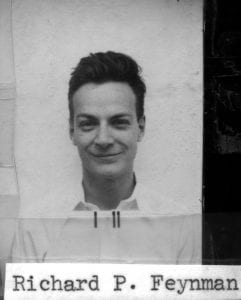
“We are at the very beginning of time for the human race. It is not unreasonable that we grapple with problems. There are tens of thousands of years in the future. Our responsibility is to do what we can, learn what we can, improve the solutions and pass them on.” – Richard Feynman
“Physics is like sex: sure, it may give some practical results, but that’s not why we do it” – Richard Feynman
Richard Feynman was a legendary theoretical physicist, educator, and writer. He is most famous for winning the Nobel Prize for Physics as part of the team that discovered Quantum Electrodynamics, developing the eponymous Feynman Diagrams that are commonly used to show the interactions of subatomic particles, and his role in the Challenger Investigation. But he is most beloved for his writing, his self depreciating manner, his impish and idiosyncratic sense of humor — during his time at Los Alamos he would figure out the combinations of his peers lockers and leave them notes inside —, his love of drums, and his voice as a lucid educator of the public — most famously during the aforementioned Challenger investigation. Science might eventually get over it’s massive crush on Feynman but don’t expect it to happen any time soon.
Youth
He was born in Far Rockaway a town in Queens on May 11, 1918 to Russian and Polish Jewish Immigrants. He kept the thick New York accent for the rest of his life. During his youth he would teach himself a wide verity of advanced mathematics, and would invent his own symbols for log, sin, cos, as well as the inverse trig functions because he didn’t like how they looked like three variables multiplied together. He also built a variety of rudimentary electronics including a homemade burglar alarm that freaked his parents when they set it off out one night. Using this knowledge he became the neighborhood handy-boy fixing friends and relatives radios. When he was 9 years old, his mother gave birth to a younger sister Joan. While their mother would discourage Joan from pursuing science because she believed that women didn’t have the “cranial capacity”. Richard however encouraged her and she is now a mostly retired but highly respected astrophysicist.
Manhatten Project
During the lead up to WW2 he worked on building mechanical computers used in calculating ballistics problems, until the problem became how to time a shell when the fuse wouldn’t burn. After leaving he was brought onto the Manhattan Project by Bob Wilson. Members of his team were told not to buy train tickets for Albuquerque because all the physicists going to the middle of nowhere would raise suspicions. Feynman reasoned that if everyone else bought tickets going elsewhere he could buy a ticket there without it raising eyebrows. Consequently he and his wife were some of the first to arrive. His wife Arline was slowly dying from tuberculosis, and Feynman’s regular visits to town to go see her inspired Klaus Fuchs, whose car Feynman was using, to say that he thought Feynman was the most likely person at Los Alamos to be a traitor. Funnily enough Klaus was the one who was later discovered as a spy. While at Los Alamos Feynman worked on a variety of projects. These included developing the formula for calculating the yield of a fission bomb alongside Hans Bethe, and helping supervise the computers, both human and digital. He lead the team working the big IBM machines doing the heavy calculations.
Throughout his time at Los Alamos he was a strong proponent of explaining to people how things actually worked because it allowed them to be way better at their jobs. He also tried to raise awareness of the shabby state of physical security in the Lab by breaking into locked filing cabinets, desk drawers, and even safes. It was during this time that he gained his reputation as a prankster (he would leave notes in people’s cabinets letting them know that he’d borrowed their classified files) and as a skilled safecracker. When one of Feynman’s friends, Frederic de Hoffman, was working declassifying files Feynman broke into his filing cabinets that contained all the knowledge required to develop a functioning bomb and nearly gave the poor man a heart attack. The combination to all of these cases had been the first 6 digits of e.
A month before the Trinity Test Arliene died. During the Trinity Test Feynman choose not to wear the heavy glasses provided to observe the explosion. Instead relying on the windshield to filter out the blast of UV radiation. This didn’t work as well as he’d hoped and the flash was so bright that even after he ducked he saw a purple splotch of an after image on the floor of the car. According to Feynman he was probably the only one who “saw it with the human eye” because everyone else was wearing dark glasses and/or lying on the floor.
Teaching
After the war Feynman left Los Alamos to teach at Cornell. On his first night there all the hotels were full. He thought about sleeping in some leaves outside but decided against it because he was trying to act dignified. He ended up sleeping on a couch in the lounge of one of the buildings. During this time he briefly lost his mojo before re-approaching physics from the direction of play. He was inspired by the wobbling of a plate that a student was tossing in the air to go back and play with the stuff that would eventually become Quantum Electrodynamics.
A few years later Caltech asked Feynman to come teach there setting off a frankly ridiculous bidding war between Cornell and Caltech which Caltech won when they offered to let him have a Sabbatical year before he even started working. He spent that Sabbatical in Brazil teaching physics and learning how to play the frigideira which is a frying pan that is used as a percussion instrument in Samba music. He got good enough at it that he became part of a local samba band and played during Carnival. While in Brazil he also proposed to his second wife. Upon returning he did professoring things for a while. Among other thing he learned to draw and paint, did his grading in strip clubs, asked female students if they would do nude modelling for him (different times I guess? Though honestly still pretty blech), and did the work that would eventually win him his Nobel prize.
My Grandfather went to Caltech on the GI bill after working as a radar technician in Britain after WW2. While there he had the great privilege of taking one of his upper div physics classes from Feynman. Apparently he was a masterful lecturer but a poor giver of tests. During the course Feynman assigned no homework, and for the final put just a few big problems on the board that he thought up off the top of his head. They were exceptionally hard and my Grandfather spent the whole time working on one of them. Very few people managed to solve even one. He did managed to solve one and got a C in the class.
He was reluctant to accept the Prize. He cancelled the big reception party that he was supposed to throw, had serious anxiety over writing his speech, and resented the notoriety he gained from winning. He would later bill himself as Professor Henry Warren from the University of Washington at events at UC Irvine so that only students actually interested in the science would show up.
Challenger
The last great story of Feynman’s career was his role in the Challenger Investigation. In 1986 the Challenger space shuttle blew up in flight in one of the most famous disasters in aerospace history. Feynman was invited to join the investigation which he reluctantly did despite bad experience with other Washington boards and doubts that he would contribute much. However he became even more famous for his display in one of the early hearings. He took a piece of the rubber used in the seal dipped it in ice water and then showed how it lost its flexibility. This was later concluded to be one of the leading factors in the rupture of the O-ring seal which caused the accident.
Conclusion
Feynman is and always will be a legend. He was a giant of his age. Much of modern physics can trace a direct line to his work. He was a consummate adventurer, a brilliant and inspiring writer, a great wit, and a clear and enthusiastic educator. He wasn’t one of the top dogs at Los Alamos, but he did play an important role. His words and work are still easily accessible and if you find yourself looking for joy in understanding the world around you I’d recommend taking a look. Or if you just want some good belly laughs take a look read through his book of hysterical personal anecdotes “Surely You’re Joking Mr Feynmann”.
Sources:
Surely You’re Joking Mr Feynman
Wikipedia: Richard Feynman
Encyclopedia Brittanica

